Your Cart is Empty

Metal Clay Rotary Tool Finishing
3 min read
Understanding a little about the properties of your metal and what the process you are using is actually doing (albeit on a microscopic level) will help in diagnosing issues you may encounter. It will also give you more insight into how to accomplish the various metal finishing possibilities.
Silver formed with metal clay tends to have a microscopic porous surface when compared to cast or sheet metal. Although these tool tips apply to most finishing attachments, you should always take note of the manufactures recommended usage. This should always be your starting point with any new attachments before making any usage adjustments to suit your needs.
Safety: Hello, we all know the rules right?
Safety Glasses: Unless you are capable of examining your piece under a microscope, you have no way of knowing the level of attachment of each element added. When (yes, WHEN) an element detaches under the rotary tool, it is travelling at a speed that can pierce the eye. Please make safety glasses a condition of touching your Rotary tool.
Dust Mask: This may be challenging to get you to take this as seriously as safety glasses. Have you read "How Working With Metal Clay Can Be Hazardous To Your Health"?

When using Fiber wheels or 3M bristle discs rotary tool attachments, you are in effect removing metal.
With these attachments you can achieve a silky smooth satin finish to you metal. Always proceed gradually, especially when working with such a soft metal as Fine Silver.
The next key is to use the attachments ranging from the most course to the finest grit. As with any attachment, ALWAYS let the tool do the work………don’t apply heavy force. This is especially true with your course attachments as they remove metal, leaving scratch marks.
Generally – The finer the attachment the higher the speed you should apply to your tool.
Remember ALWAYS let the tool do the work………don’t apply heavy force
So how do you get that mirror finish?

A "Tumbler" which achieves a polished finish by "burnishing" the surface when the steel shot is constantly rubbing against the surface. This works well depending on the embellishments of your piece.
However, this option is not suitable when soldering a bezel setting as the risk of damaging the gemstone is ever present. Also, when your piece has an intricate design especially when dimension is added a Tumbler will not provide any level of control of areas you wish to highlight.
Mult-step rotary tool attachments:
After removing any surface deformations (scratches, high points, etc.) using a combination of Fiber Wheel & Bristle disks is required to prepare for the polishing step. Depending on the hardness of the metal, this can be a 2 - 5 step process working from a grinding phase using a course attachment, to a micro-fine Bristle disc.
The final polishing step being the use of buffing pads with a polishing compound.

Felt polishing pads in combination with a polishing compound provides control of the areas to be polished.
By using this combination, you are “rearranging” the surface silver molecules due to the heat generated by the friction of the attachment.
The compound should be used "sparingly" to avoid an additional task of cleaning excess compound (dark patina looking marks). The various shapes also allow you greater access and control of the areas to be polished.
ATTENTION: Unless you fully understand the health risks implicated with the use of Silica, avoiding Silca based compounds is recommended. There are a number of non-Silca compounds available that provide the same result.
Although a hand-held Dremel ® rotary tool can get you started, you should consider that to attain the speeds required to cover all the steps, you will require a higher priced model that will cost just a little less than a Foredom ® Flex-shaft. You will find that the price difference will payoff in longevity when you have a high frequency of use.

Looking at a higher priced alternative, which can reduce production time, the JoolTool ® is a wonderful solution. Although attachment prices are higher, comparable 3M attachments are available. With the right attachments, this machine also adds the capability of reshaping and polishing gemstones.

That mirror finish is the result of;
- using the right tool and attachment,
- letting the tool do the work and
- using the highest speed rating for your polishing pad.
Achieving the same level of mirror polish than silver sheet can be challenging and would take a great amount of time. However, if you work clean and refine your clay until silky smooth BEFORE firing, this is the best way to achieve a beautiful gloss finish.
Leave a comment
Comments will be approved before showing up.
